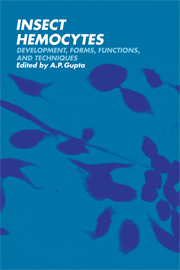Book contents
- Frontmatter
- Contents
- Preface
- List of contributors
- Part I Development and differentiation
- Part II Forms and structure
- Part III Functions
- Part IV Techniques
- 17 Identification key for hemocyte types in hanging-drop preparations
- 18 Insect hemocytes under light microscopy: techniques
- 19 Techniques for total and differential hemocyte counts and blood volume, and mitotic index determinations
- 20 Hemocyte techniques: advantages and disadvantages
- 21 Light, transmission, and scanning electron microscopic techniques for insect hemocytes
- 22 Histochemical methods for hemocytes
- Indexes
20 - Hemocyte techniques: advantages and disadvantages
Published online by Cambridge University Press: 04 August 2010
- Frontmatter
- Contents
- Preface
- List of contributors
- Part I Development and differentiation
- Part II Forms and structure
- Part III Functions
- Part IV Techniques
- 17 Identification key for hemocyte types in hanging-drop preparations
- 18 Insect hemocytes under light microscopy: techniques
- 19 Techniques for total and differential hemocyte counts and blood volume, and mitotic index determinations
- 20 Hemocyte techniques: advantages and disadvantages
- 21 Light, transmission, and scanning electron microscopic techniques for insect hemocytes
- 22 Histochemical methods for hemocytes
- Indexes
Summary
Introduction
Insect hemocytes may be studied in several ways: (1) examination of hemocytes within the living insect; (2) examination of unfixed hemolymph, stained or unstained; (3) examination of fixed hemolymph, stained or unstained (Arnold, 1974); (4) examination of sections, fixed or unfixed. It is the intent of this chapter to examine each method and to analyze its advantages and disadvantages.
Examination of insect hemocytes
Hemocytes in vivo
The ameboid motion of hemocytes of the giant cockroach, Blaberus giganteus, the course of blood circulation within the mature embryo, as well as the morphology of hemocytes and blood circulation in insect wings were studied within living insects by Arnold (1959a, b, 1960, 1961, 1964, 1966) and by Arnold and Salkeld (1967). Circulation of blood was studied in insects belonging to 14 orders. Much valuable information was obtained, but the method has limited use and has not found widespread advocacy. Jones and Tauber (1954) attempted to differential counts of hemocytes (DHCs) in the wing membrane of the mealworm, Tenebrio molitor. Counts could not be made because the cells could not be clearly seen under high magnification.
Clark and Harvey (1965) studied cellular membrane formation in diapausing Cecropia pupae by utilizing a modified telobiotic preparation. In this method, pupae were attached to a Plexiglas chamber, so that living hemocytes could be observed directly using phase-contrast optics. Attachment of plasmatocytes (PLs) and migration of cells were also studied. As the hemocyte population in the blood chamber increased, the proportion of fusiform PLs increased. These cells became rounded, however, when they made contact with the hemacytometer surfaces.
- Type
- Chapter
- Information
- Insect HemocytesDevelopment, Forms, Functions and Techniques, pp. 549 - 562Publisher: Cambridge University PressPrint publication year: 1979



